Microstructural and Very High Cycle Fatigue (VHCF) Behavior of Ti6Al4V—A Comparative Study
Abstract
1. Introduction
2. Experimental Procedures
- Heating to 730 C and holding for 2 h; air-cooling to room temperature (annealing)
- Heating to 850 C and hold it for 2 h and reheat to 960 C and holding it for 2 h; water-cooling to room temperature (solution heat treatment)
- Heating to 600 C (aging treatment) and 560 C (stress relief annealing) at each temperature holding for two hours and air-cooling to room temperature
2.1. Dynamic Modulus of Elasticity and Poisson’s Ratio Measurement by Impulse Excitation
2.2. Micro Hardness
2.3. Tensile Test
2.4. Microstructural Observation
2.5. Ultrasonic Fatigue Test
3. Results and Discussion
3.1. Dynamic Elastic Modulus and Poisson’s Ratio
3.2. Microhardness
3.3. Tensile Test
3.4. Microstructure Investigation and Chemical Composition
3.5. Ultrasonic Fatigue Test and Lifetime Prediction
4. Conclusions
- The dynamic elastic modulus and Poisson’s ratio were measured using the IET. From the results, it is evident that the material sample from manufacturer C poses the highest 114 GPa and the B material sample poses the lowest at 105 GPa which is within the standard permissible limit.
- Measurement of the microhardness analysis showed that the Vickers hardness values (HV) for A, A-H, B, and C material samples are between 360 and 370. The microhardness analysis showed that before and after the heat treatment is almost the same with 10 unit difference (0.51%).
- Using the process of microstructure investigation, the different raw materials present in each material model are estimated using the EDS mapping process. As a result of element composition mapping, Ti6Al4V basic components could be confirmed as a whole, but trace impurities of Ca were detected in the heat-treatment material sample A and trace of Fe in material sample C.
- From the tensile test, it can be seen that the maximum tensile strength value is almost the same for all the material samples, but it is also found that the material sample C is lower than that of materials of A and B at the elongation. Tensile test results before and after the heat treatments, the material sample A possesses the lowest. However, this error might be due to the sub-size plate specimen in the experiment.
- The fatigue fracture of each stress band cycle is observed, but most of the surface-based fatigue failure occurred, but in the case of material sample C, it is found that the fatigue fracture occurred at the internal origin due to large size crystal grain as a notch.
- For material model A, the fatigue strength is not only low but the data dispersion is observed highly scattered. But for material samples B and C are comparatively clustered. Moreover, material samples B and C possess slightly higher fatigue strength than A and A-H.
- The material and physical properties of impeller parts are considered to be the quality evaluation standard, thus the material sample C can be used as a high-level stable impeller core part. Moreover, the material properties of sample C firmly agree with that of the supplier technical datasheet compared to the other two material samples. Thus, according to the present experimental study, material sample C can be used as the efficient impeller core component.
Author Contributions
Funding
Conflicts of Interest
References
- Lee, W.S.; Lin, C.F. High-temperature deformation behaviour of Ti6Al4V alloy evaluated by high strain-rate compression tests. J. Mater. Process. Technol. 1998, 75, 127–136. [Google Scholar] [CrossRef]
- Zuo, J.H.; Wang, Z.G.; Han, E.H. Effect of microstructure on ultra-high cycle fatigue behavior of Ti6Al4V. Mater. Sci. Eng. A 2008, 473, 147–152. [Google Scholar] [CrossRef]
- Shao, F.; Liu, Z.; Wan, Y.; Shi, Z. Finite element simulation of machining of Ti6Al4V alloy with thermodynamical constitutive equation. Int. J. Adv. Manuf. Technol. 2010, 49, 431–439. [Google Scholar] [CrossRef]
- Xu, W.; Lui, E.W.; Pateras, A.; Qian, M.; Brandt, M. In situ tailoring microstructure in additively manufactured Ti6Al4V for superior mechanical performance. Acta Mater. 2017, 125, 390–400. [Google Scholar] [CrossRef]
- Agius, D.; Kourousis, K.I.; Wallbrink, C. A review of the as-built SLM Ti6Al4V mechanical properties towards achieving fatigue resistant designs. Metals 2018, 8, 75. [Google Scholar] [CrossRef]
- Zhao, Z.Y.; Li, L.; Bai, P.K.; Jin, Y.; Wu, L.Y.; Li, J.; Guan, R.G.; Qu, H.Q. The heat treatment influence on the microstructure and hardness of TC4 titanium alloy manufactured via selective laser melting. Materials 2018, 11, 1318. [Google Scholar] [CrossRef]
- Leyens, C.; Peters, M. Titanium and Titanium Alloys Fundamentals and Applications; Wiley-VCH: Weinheim, Germany, 2003; p. 513. [Google Scholar]
- Jiao, L.; Miaoquan, L.; Weixin, Y. Microstructure Evolution during High Temperature Deformation of Ti-6Al-4V Alloy. Rare Met. Mater. Eng. 2010, 39, 1323–1328. [Google Scholar] [CrossRef]
- Chern, A.H.; Nandwana, P.; Yuan, T.; Kirka, M.M.; Dehoff, R.R.; Liaw, P.K.; Duty, C.E. A review on the fatigue behavior of Ti6Al4V fabricated by electron beam melting additive manufacturing. Int. J. Fatigue 2018, 119, 173–184. [Google Scholar] [CrossRef]
- Liu, S.; Shin, Y.C. Additive manufacturing of Ti6Al4V alloy: A review. Mater. Des. 2018, 164, 107552. [Google Scholar] [CrossRef]
- He, J.; Li, D.; Jiang, W.; Ke, L.; Qin, G.; Ye, Y.; Qin, Q.; Qiu, D. The Martensitic Transformation and Mechanical Properties of Ti6Al4V Prepared via Selective Laser Melting. Materials 2019, 12, 321. [Google Scholar] [CrossRef]
- Mishurova, T.; Cabeza, S.; Artzt, K.; Haubrich, J.; Klaus, M.; Genzel, C.; Requena, G.; Bruno, G. An assessment of subsurface residual stress analysis in SLM Ti6Al4V. Materials 2017, 10, 348. [Google Scholar] [CrossRef] [PubMed]
- Hinterlechner, I.; Barriobero-Vila, P.; Reitinger, B.; Fromherz, T.; Requena, G.; Burgholzer, P. In-situ monitoring of phase transformation in Ti-6Al-6V-2Sn using laser ultrasonics. Nondestruct. Test. Eval. 2018, 33, 130–138. [Google Scholar] [CrossRef]
- Williams, J.C.; Starke, E.A. Progress in structural materials for aerospace systems. Acta Mater. 2003, 51, 5775–5799. [Google Scholar] [CrossRef]
- Günther, J.; Krewerth, D.; Lippmann, T.; Leuders, S.; Tröster, T.; Weidner, A.; Biermann, H.; Niendorf, T. Fatigue life of additively manufactured Ti6Al4V in the very high cycle fatigue regime. Int. J. Fatigue 2017, 94, 236–245. [Google Scholar] [CrossRef]
- Milošević, I.; Seisenbacher, B.; Winter, G.; Grün, F.; Kober, M. Fatigue life assessment regarding different influences on the HCF/VHCF behavior of a martensitic steel. MATEC Web Conf. 2018, 165, 4–9. [Google Scholar] [CrossRef][Green Version]
- Bao, X.; Cheng, L.; Ding, J.; Chen, X.; Lu, K.; Cui, W. The effect of microstructure and axial tension on three-point bending fatigue behavior of TC4 in high cycle and very high cycle regimes. Materials 2020, 13, 68. [Google Scholar] [CrossRef]
- Marines, I.; Bin, X.; Bathias, C. An understanding of very high cycle fatigue of metals. Int. J. Fatigue 2003, 25, 1101–1107. [Google Scholar] [CrossRef]
- Bathias, C.; Drouillac, L.; Le François, P. How and why the fatigue S-N curve does not approach a horizontal asymptote. Int. J. Fatigue 2001, 23, 143–151. [Google Scholar] [CrossRef]
- Lütjering, G.; Williams, J.C. Titanium, 2nd ed.; Springer: Cham, Switzerland, 2006; p. 306. [Google Scholar]
- Wanying, L.; Yuanhua, L.; Yuhai, C.; Taihe, S.; Singh, A. Effect of Different Heat Treatments on Microstructure and Mechanical Properties of Ti6Al4V Titanium Alloy. Rare Met. Mater. Eng. 2017, 46, 634–639. [Google Scholar] [CrossRef]
- Julien, R.; Velay, V.; Vidal, V.; Dahan, Y.; Forestier, R.; Rézaï-Aria, F. Tensile behaviour of high temperature forged Ti6Al4V during in-situ heat treatments. Mater. Lett. 2017, 208, 7–9. [Google Scholar] [CrossRef]
- Barriobero-Vila, P.; Gussone, J.; Haubrich, J.; Sandlöbes, S.; Da Silva, J.C.; Cloetens, P.; Schell, N.; Requena, G. Inducing stable α + β microstructures during selective laser melting of Ti6Al4V using intensified intrinsic heat treatments. Materials 2017, 10, 268. [Google Scholar] [CrossRef] [PubMed]
- El-Hadad, S.; Nady, M.; Khalifa, W.; Shash, A. Influence of heat treatment conditions on the mechanical properties of Ti6Al4V alloy. Can. Metall. Q. 2018, 57, 186–193. [Google Scholar] [CrossRef]
- Gao, H.j.; Zhang, Y.d.; Wu, Q.; Song, J. Experimental Investigation on the Fatigue Life of Ti-6Al-4V Treated by Vibratory Stress Relief. Metals 2017, 7, 158. [Google Scholar] [CrossRef]
- ASTM. Standard Test Method for Dynamic Young’s Modulus, Shear Modulus, and Poisson’s Ratio by Impulse Excitation of Vibration Designation: E 1876-01; ASTM International: West Conshohocken, PA, USA, 2005; pp. 1–16. [Google Scholar]
- Sajid, S.; Chouinard, L.; Carino, N. Robustness of Resonant Frequency Test for Strength Estimation of Concrete. Adv. Civ. Eng. Mater. 2019, 8, 20190059. [Google Scholar] [CrossRef]
- Poondla, N.; Srivatsan, T.S.; Patnaik, A.; Petraroli, M. A study of the microstructure and hardness of two titanium alloys: Commercially pure and Ti6Al4V. J. Alloy Compd. 2009, 486, 162–167. [Google Scholar] [CrossRef]
- Mahdavinejad, R.A.; Khani, N.; Fakhrabadi, M.M.S. Optimization of milling parameters using artificial neural network and artificial immune system. J. Mech. Sci. Technol. 2012, 26, 4097–4104. [Google Scholar] [CrossRef]
- Wagner, D.; Cavalieri, F.J.; Bathias, C.; Ranc, N. Ultrasonic fatigue tests at high temperature on an austenitic steel. Propuls. Power Res. 2012, 1, 29–35. [Google Scholar] [CrossRef]
- Sajid, H.U.; Kiran, R. Influence of stress concentration and cooling methods on post-fire mechanical behavior of ASTM A36 steels. Constr. Build. Mater. 2018, 186, 920–945. [Google Scholar] [CrossRef]



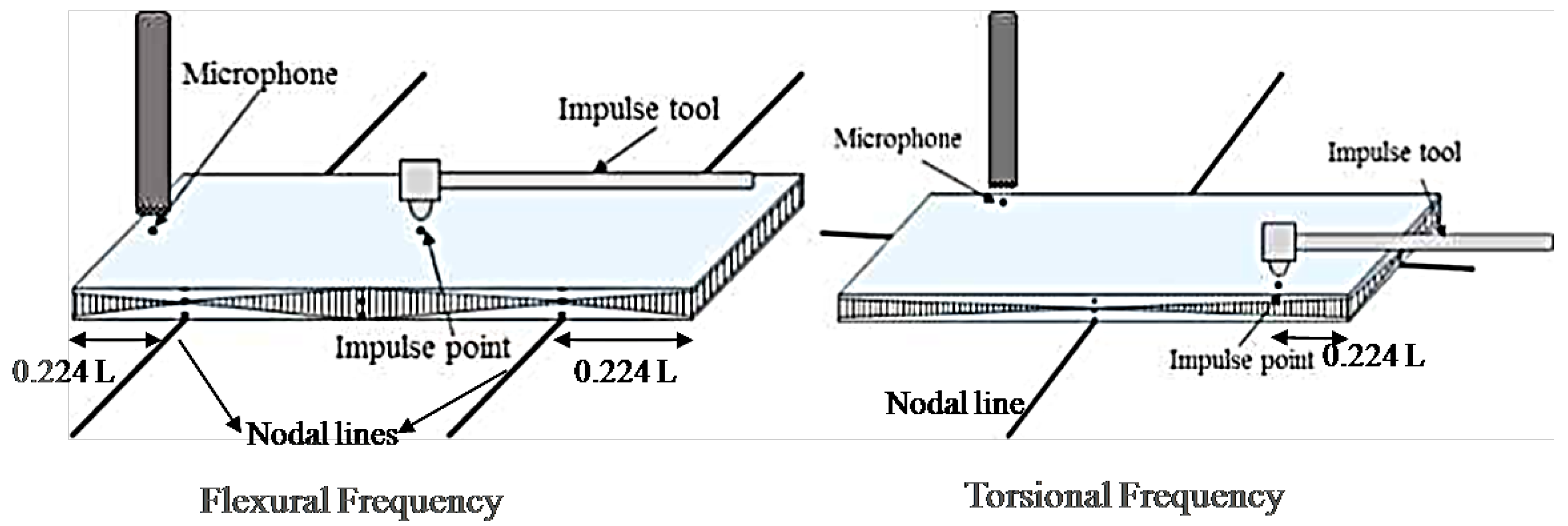
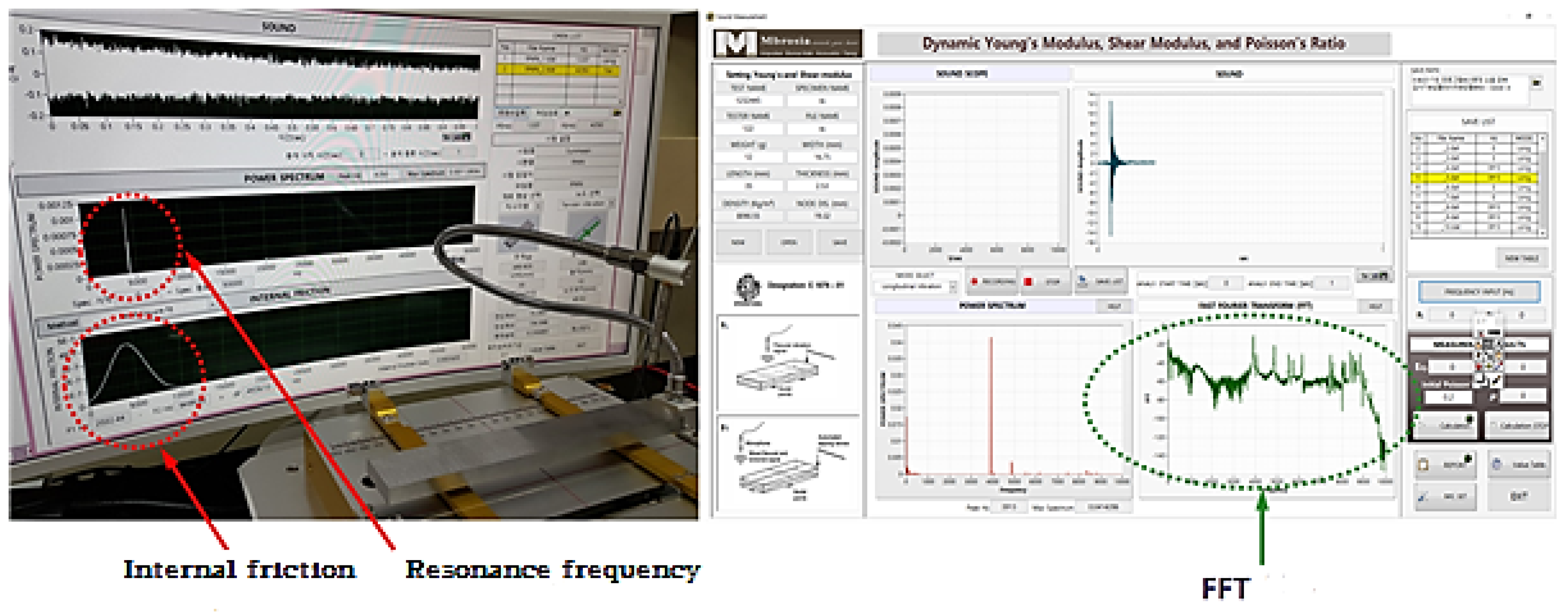
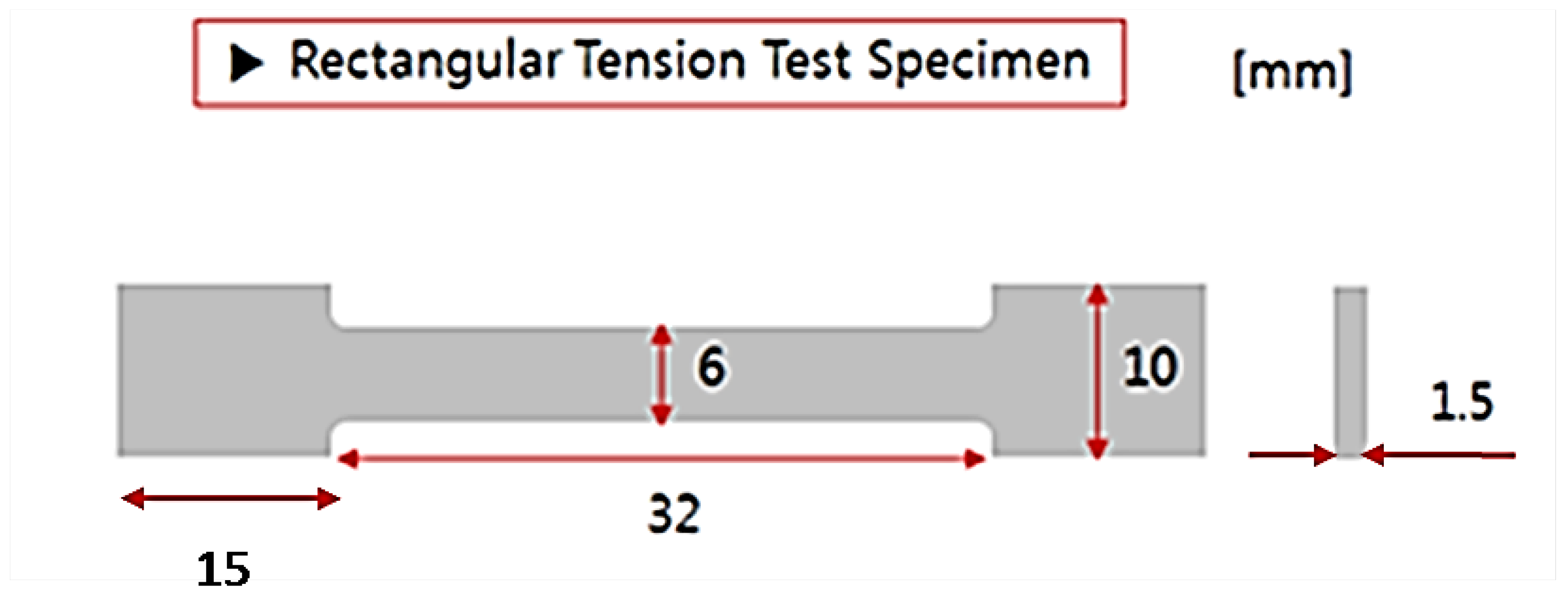
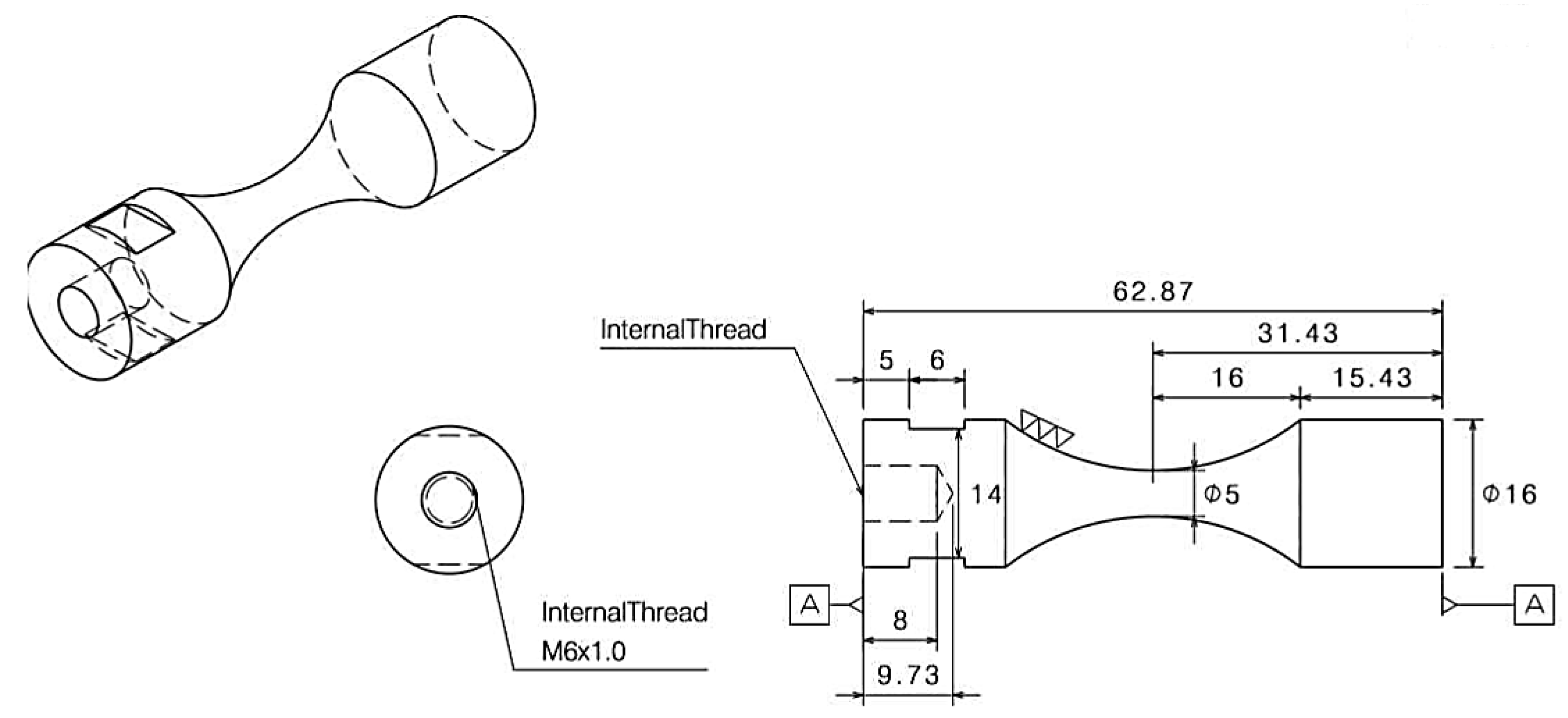

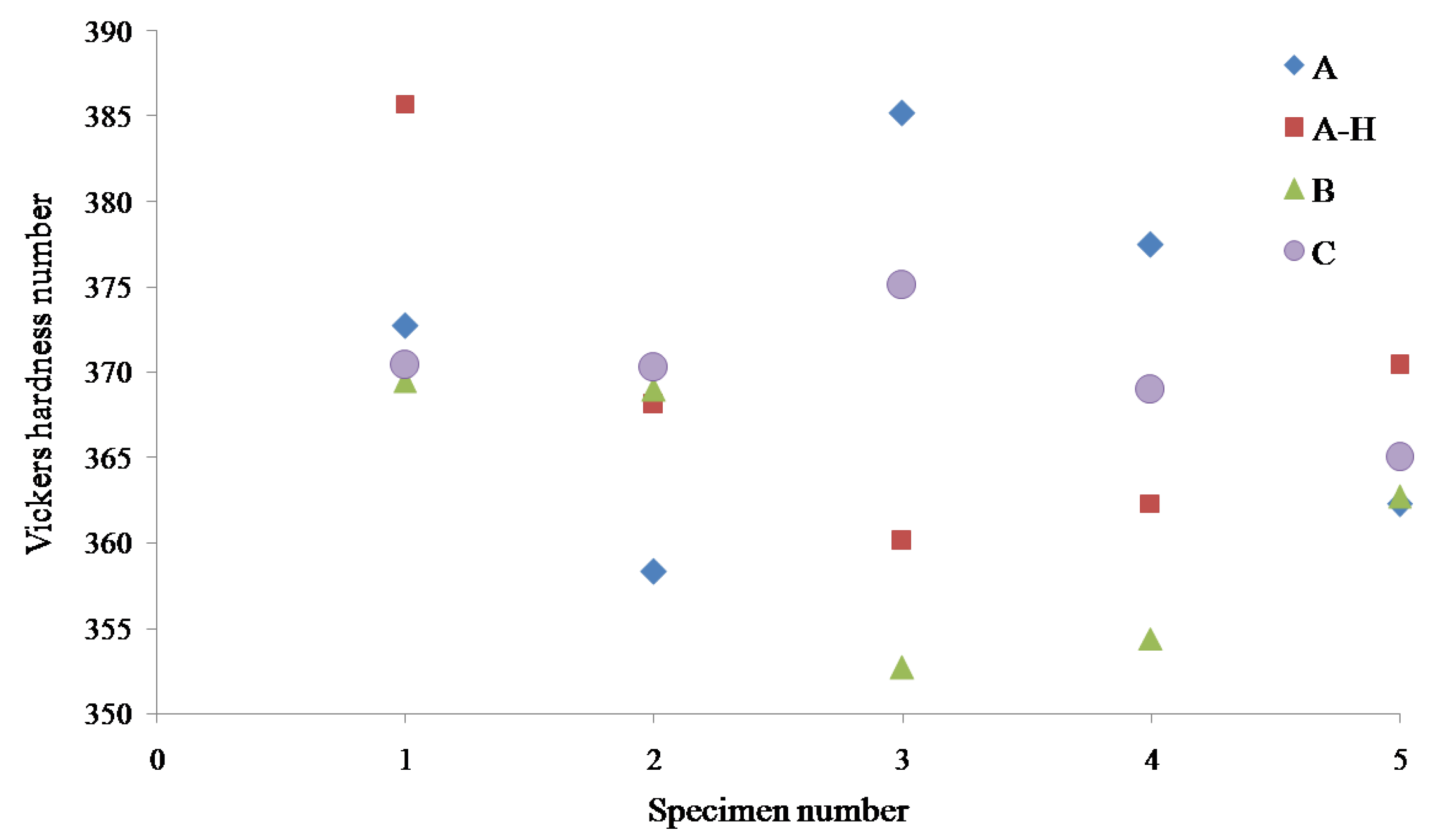


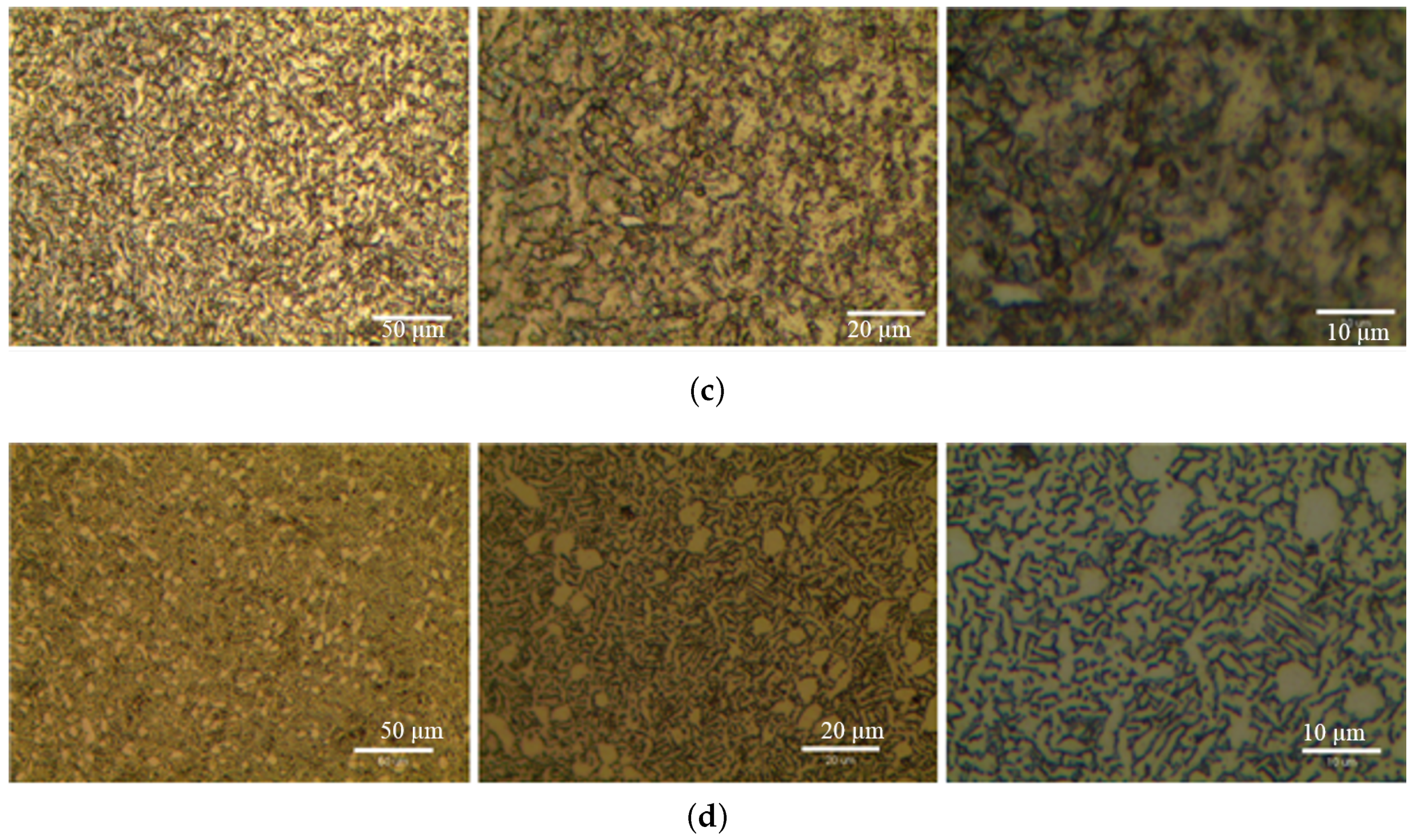
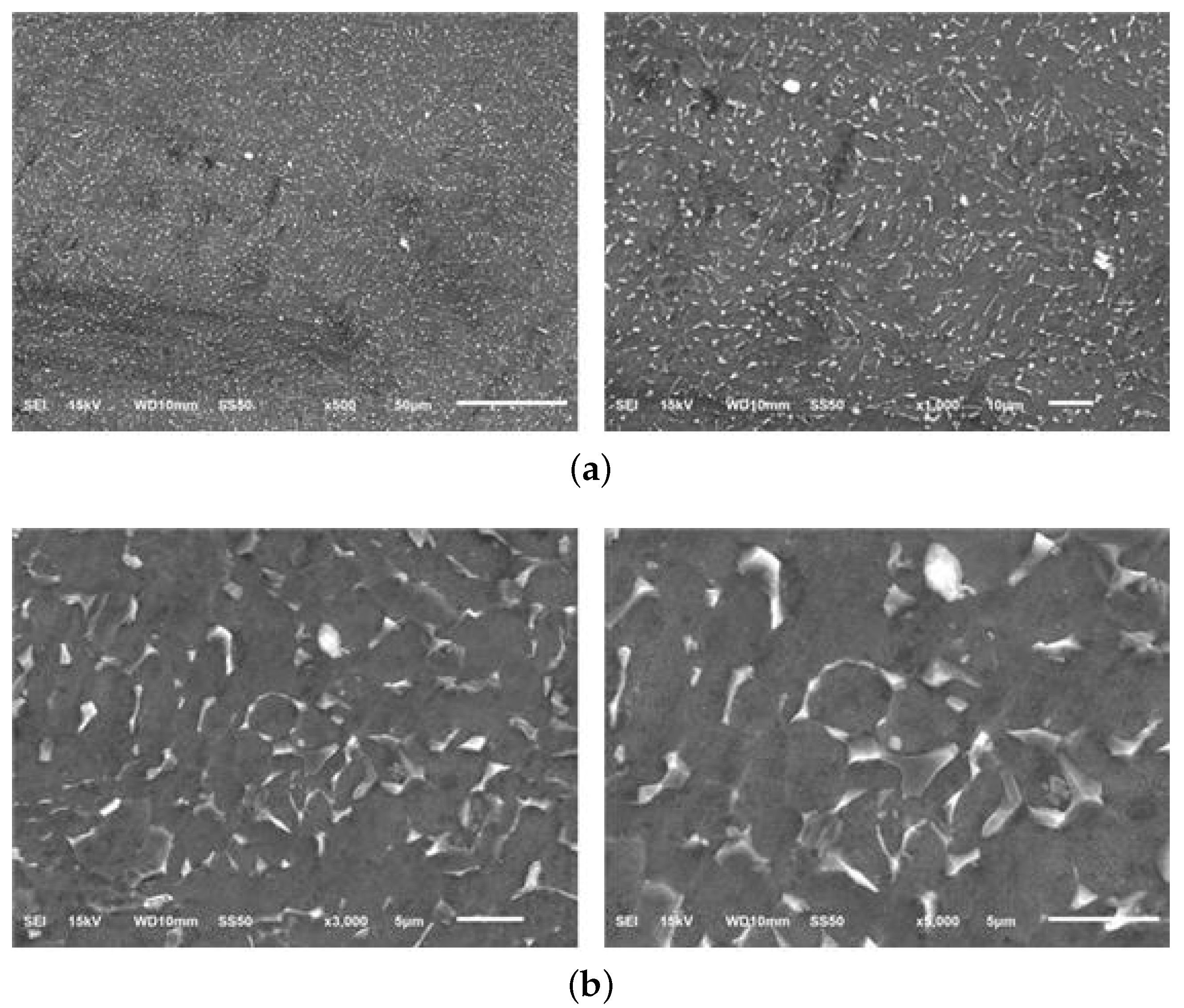
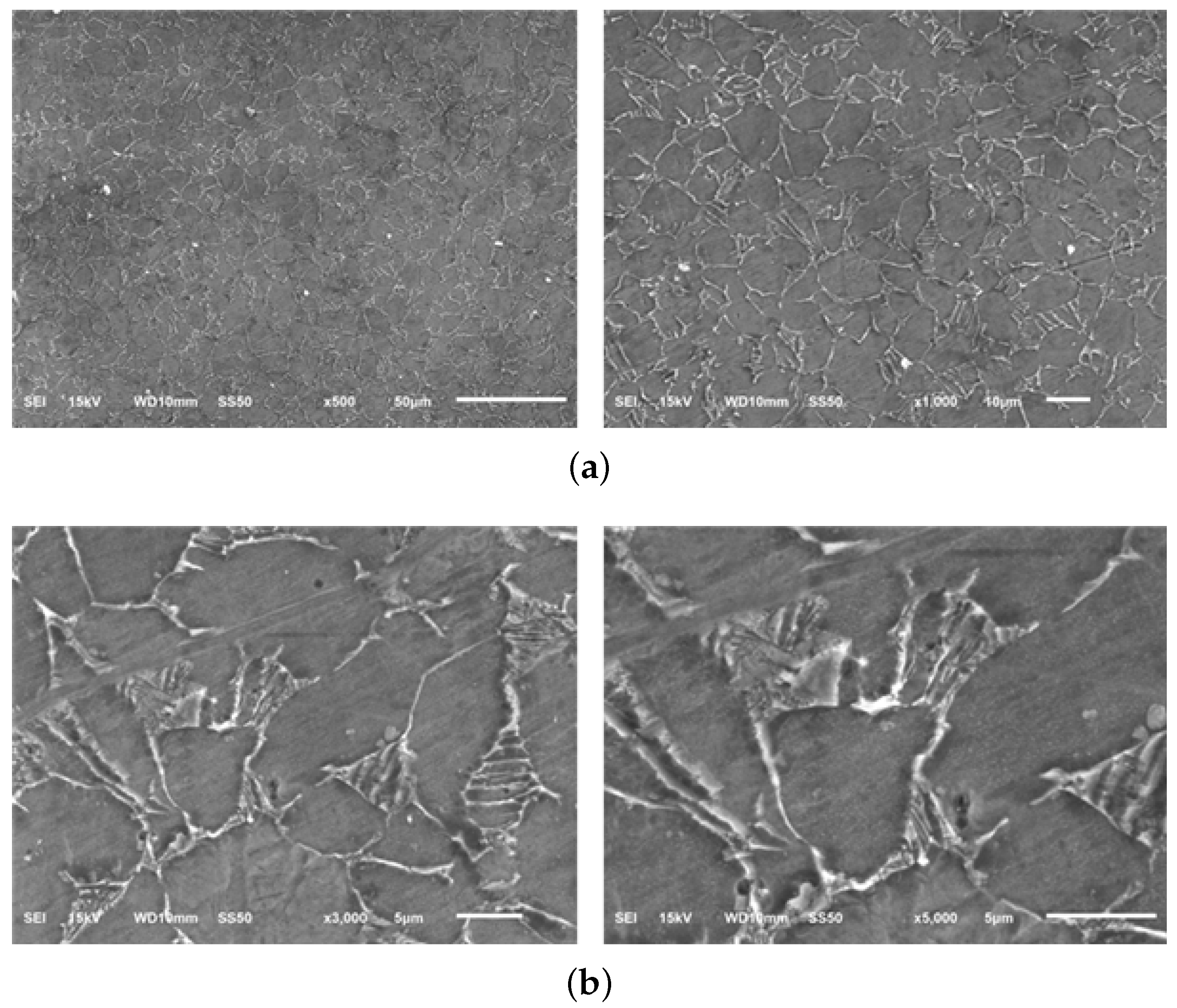
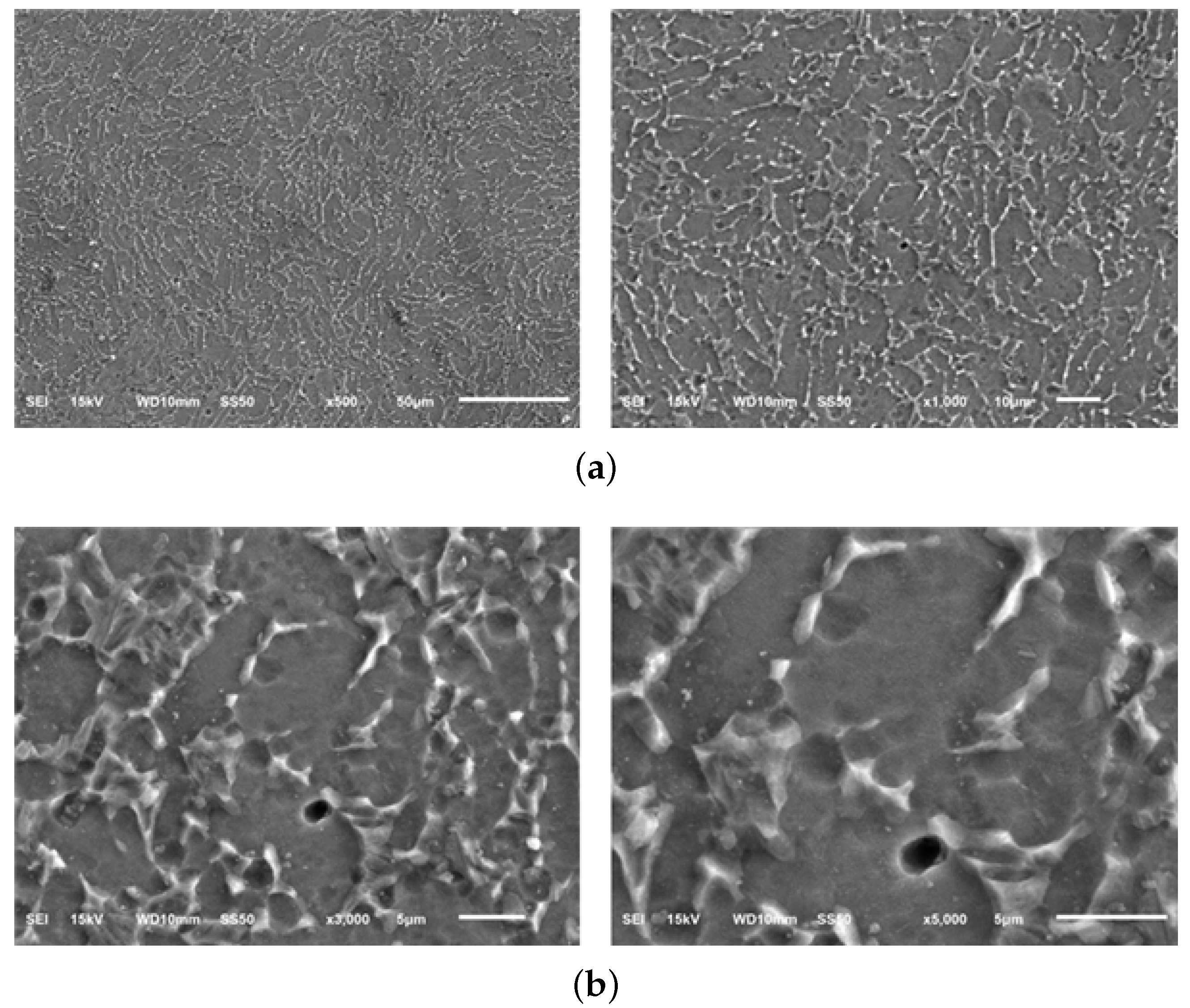
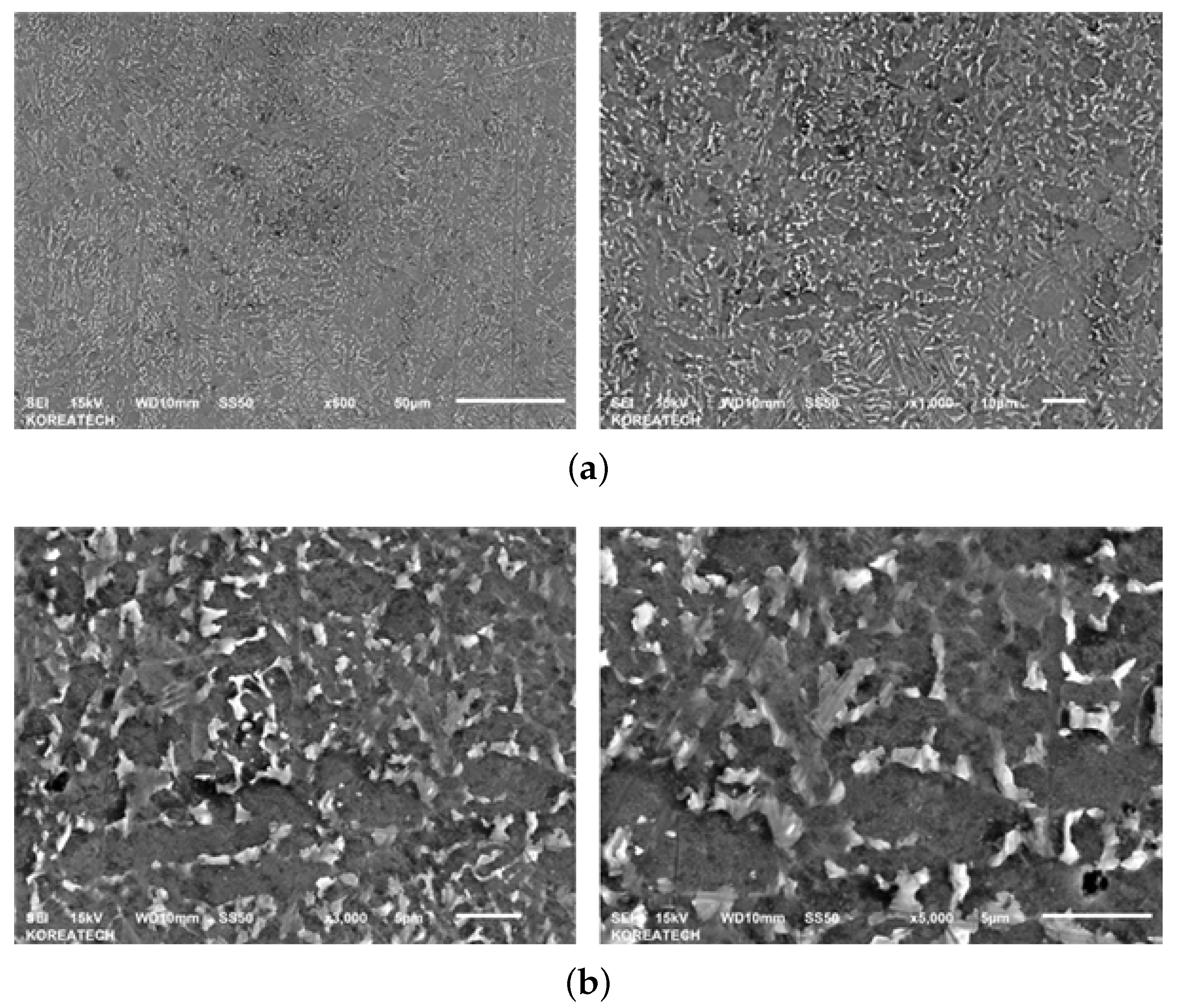
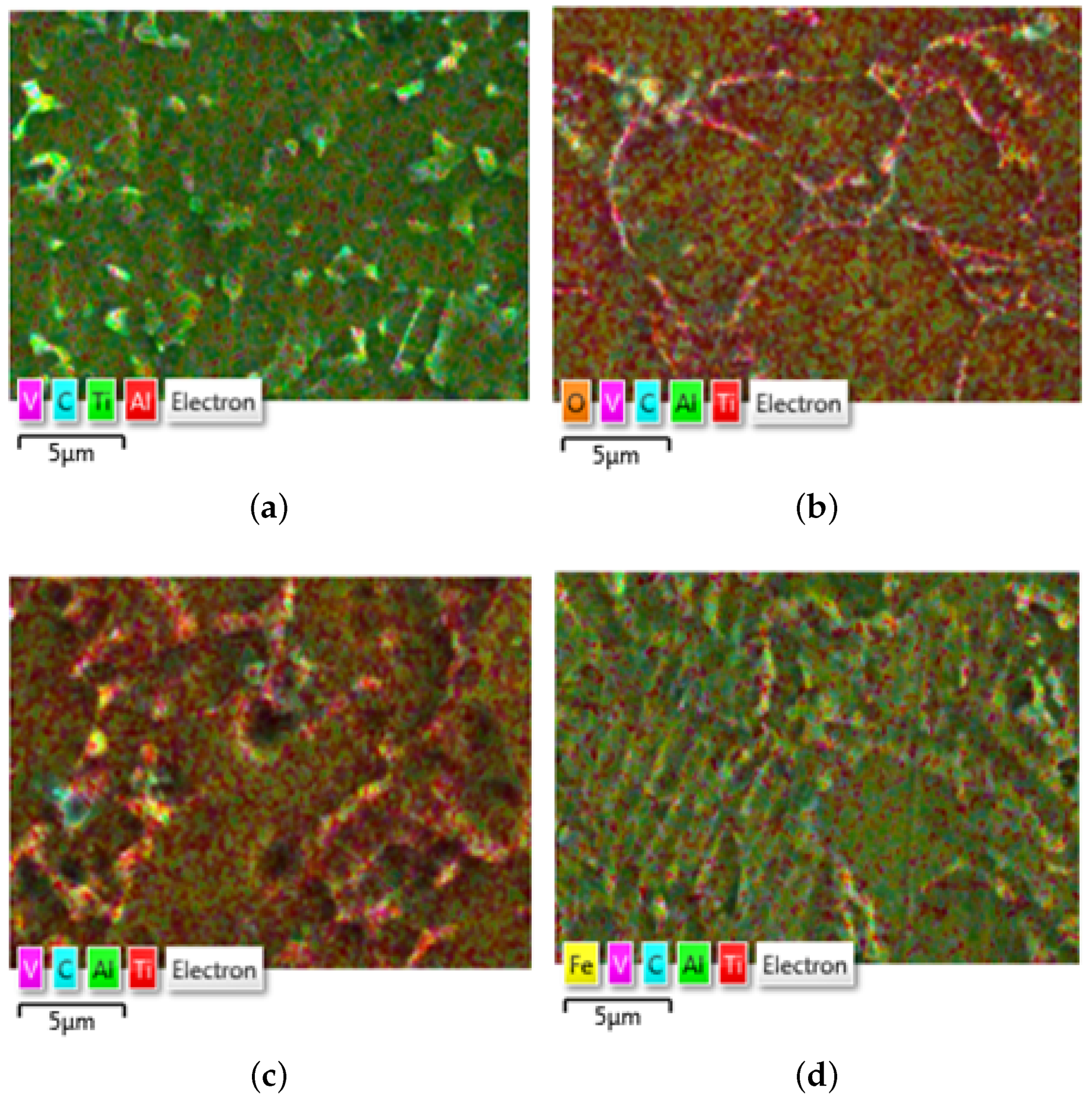
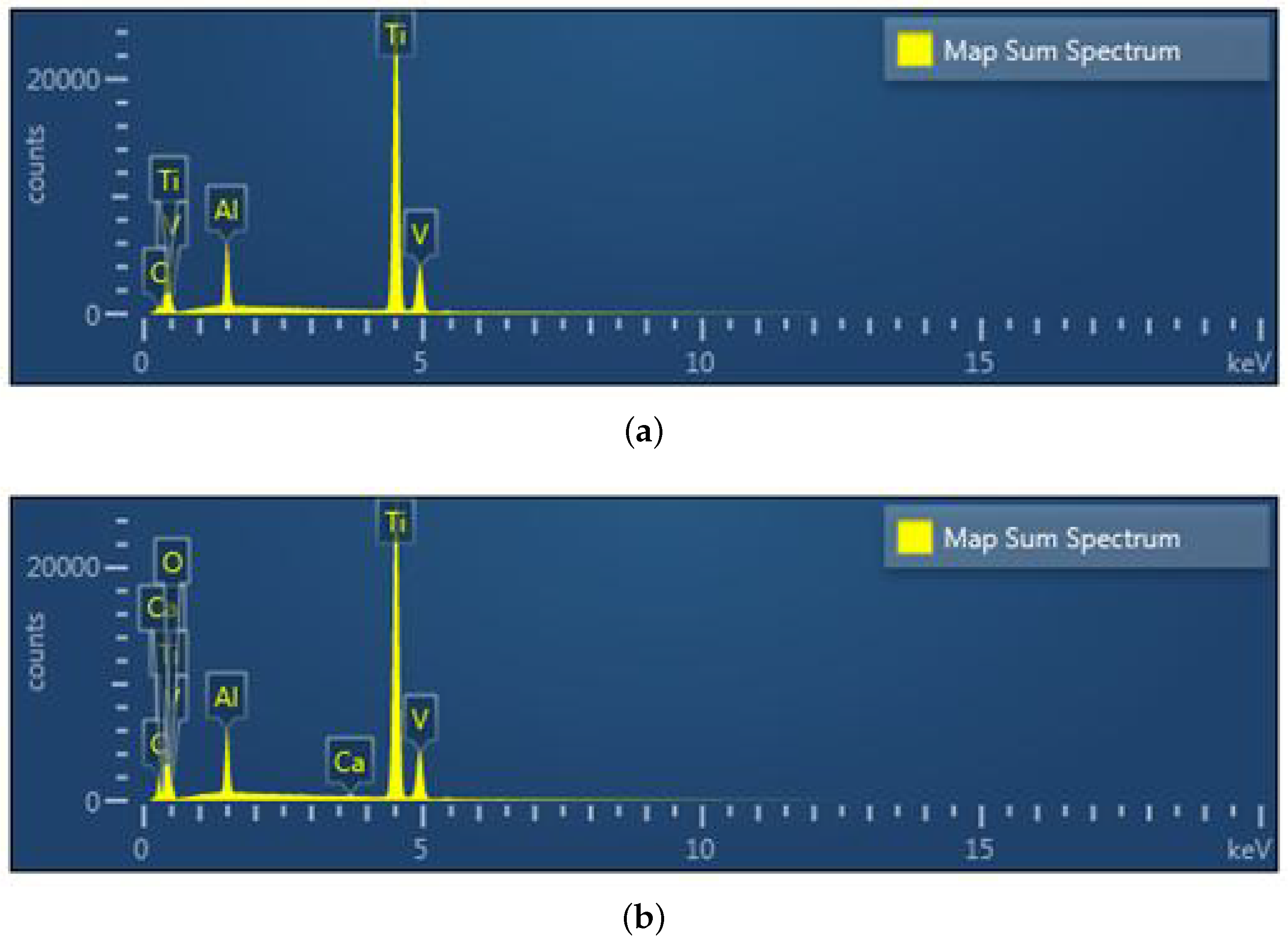
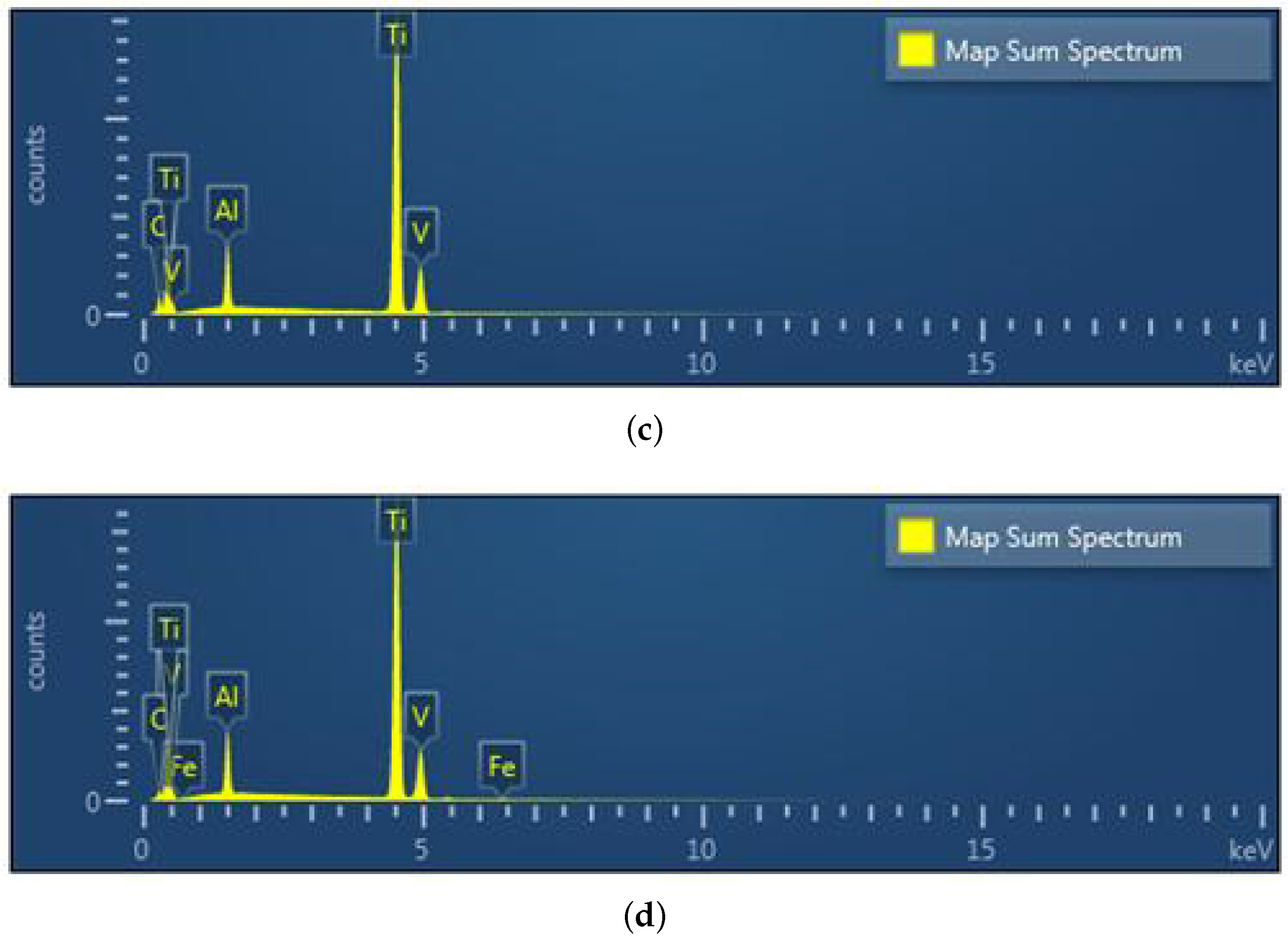
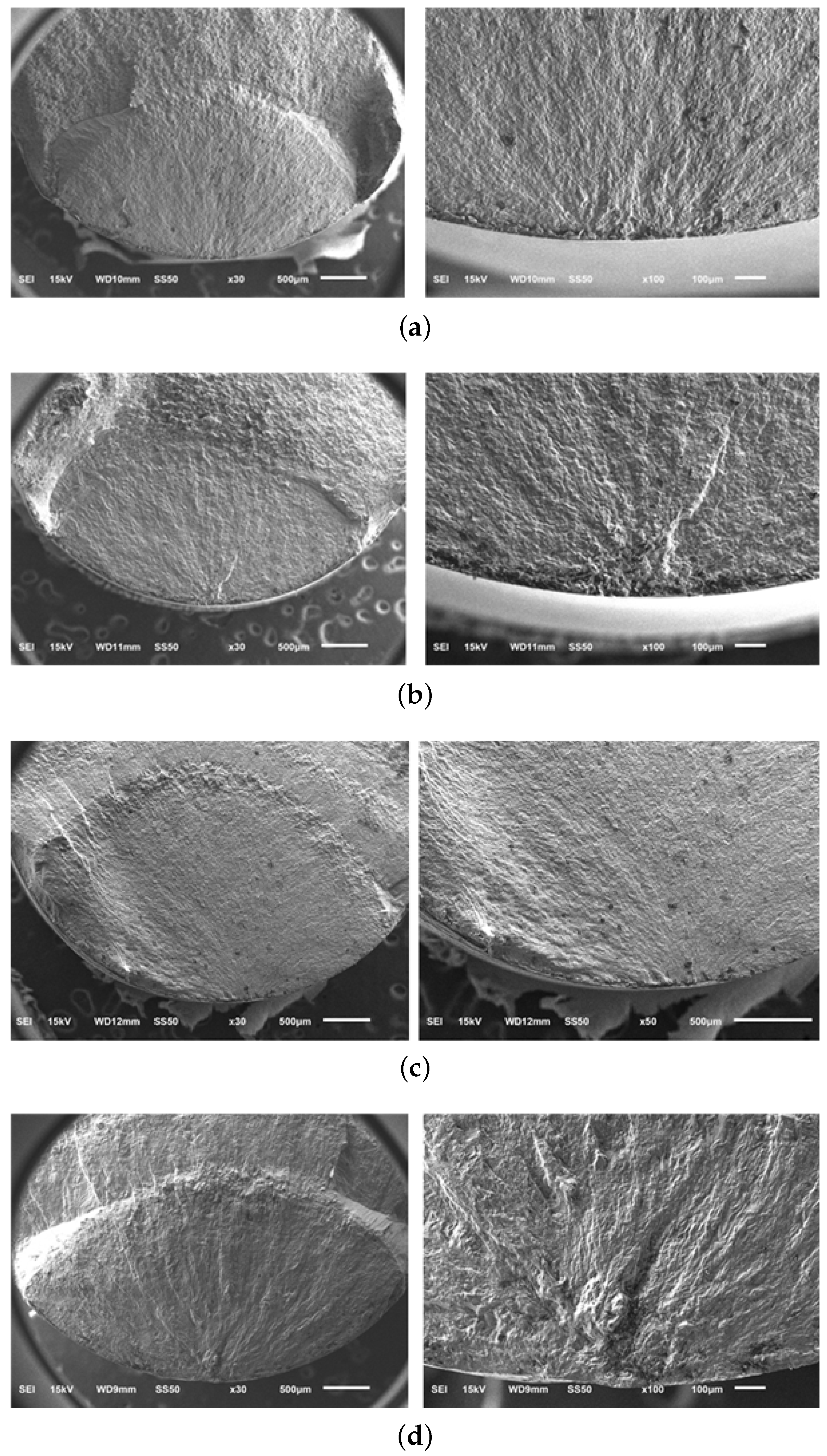
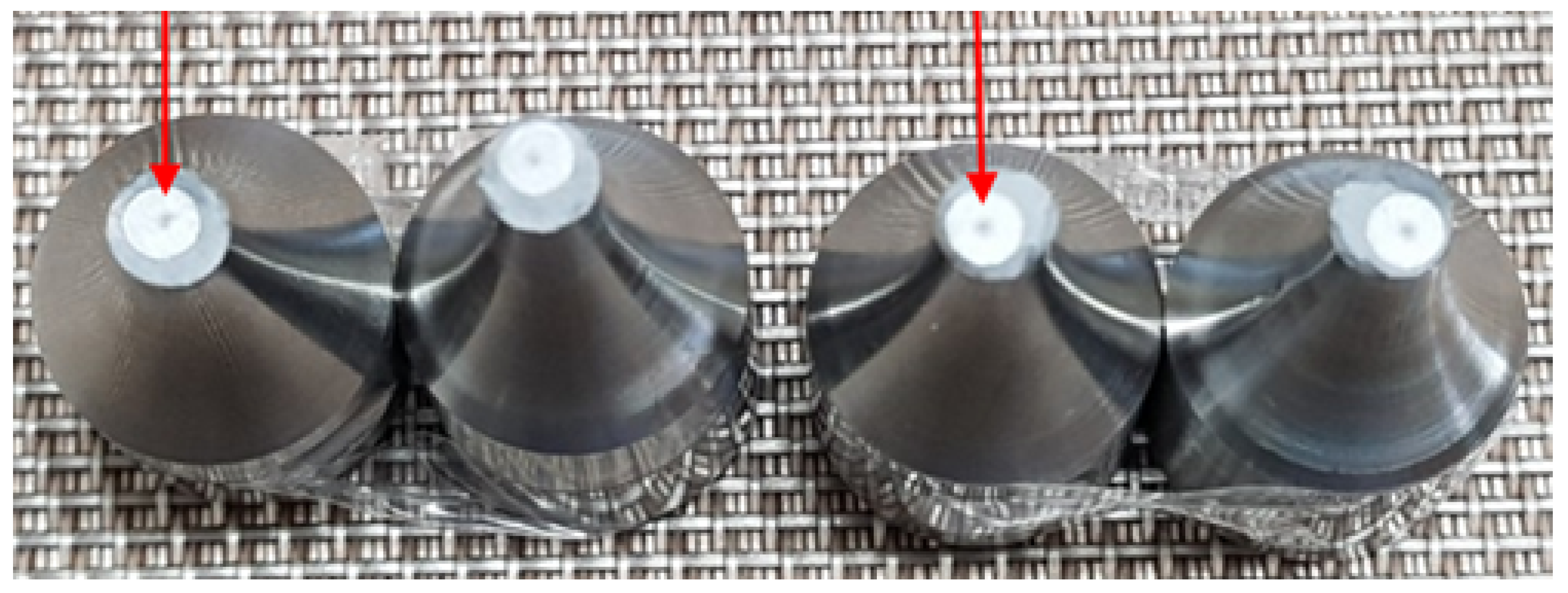
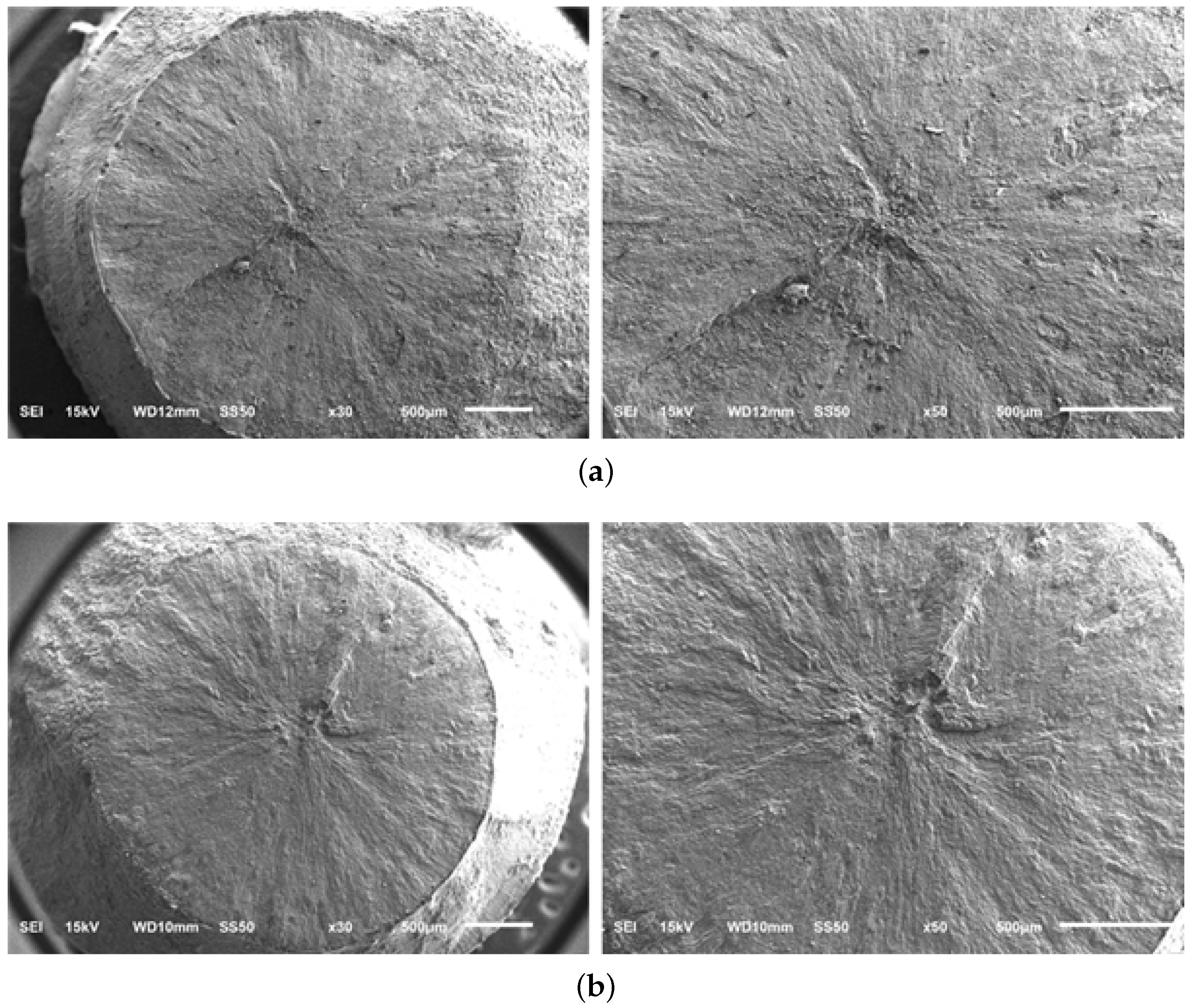
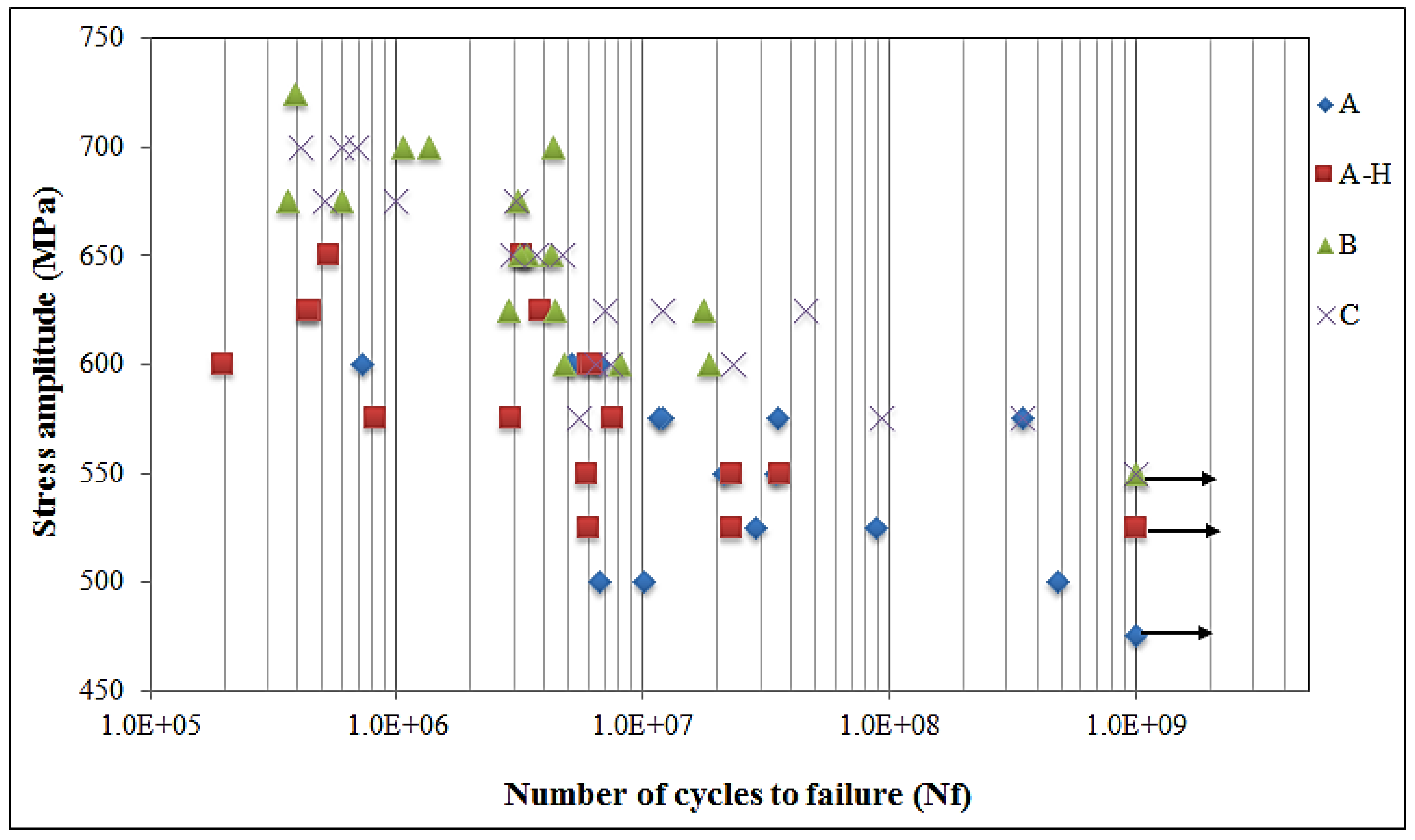
| Loading Frequency | Stress Ratio (R) | Stress Range | Cycle | Test Atmosphere |
|---|---|---|---|---|
| 20 kHz | −1 | 450–750 MPa | 10– | Room temperature |
| Sample | Frequency (Hz) | Young’s Modulus | Shear Modulus | Density | Poisson’s Ratio | |
|---|---|---|---|---|---|---|
| 1 | 2 | (GPa) | (GPa) | (kg/m) | ||
| A | 4789 | 8714 | 109.547 ± 0.2 | 43.078 ± 0.2 | 4376 | 0.271 |
| A-H | 4752 | 8630 | 109.417 ± 0.2 | 42.618 ± 0.2 | 4350 | 0.283 |
| B | 4602 | 8318 | 105.149 ± 0.2 | 40.811 ± 0.2 | 4384 | 0.288 |
| C | 4762 | 8622 | 114.064 ± 0.2 | 44.143 ± 0.2 | 4395 | 0.291 |
| Sample | A | A-H | B | C |
|---|---|---|---|---|
| 1 | 372.7 | 385.7 | 369.5 | 370.4 |
| 2 | 358.3 | 368.1 | 369.0 | 370.3 |
| 3 | 385.2 | 360.1 | 352.7 | 375.1 |
| 4 | 377.5 | 362.3 | 354.4 | 369.0 |
| 5 | 362.3 | 370.4 | 362.7 | 365.0 |
| Average | 371.2 | 369.3 | 361.7 | 370.0 |
| Sample | A | A-H | B | C | ||||
|---|---|---|---|---|---|---|---|---|
| #1 | #2 | #1 | #2 | #1 | #2 | #1 | #2 | |
| Maximum tensile strength (MPa) | 938 | 959 | 911 | 903 | 939 | 997 | 934 | 962 |
| Elongation (%) | 19.1 | 20.1 | 18.7 | 18.5 | 18.6 | 20.0 | 16.4 | 17.6 |
| Material Sample | Weight (%) | Element | ||||||
|---|---|---|---|---|---|---|---|---|
| Ti | Al | V | C | O | Ca | Fe | ||
| A | Weight (%) | 87.97 | 6.02 | 3.94 | 2.07 | - | - | - |
| Atomic weight (%) | 79.54 | 9.66 | 3.35 | 7.45 | - | - | - | |
| A-H | Weight (%) | 79.16 | 5.27 | 4.03 | 5.98 | 5.29 | 0.27 | - |
| Atomic weight (%) | 59.83 | 7.08 | 2.86 | 18.03 | 11.96 | 0.24 | - | |
| B | Weight (%) | 85.64 | 5.81 | 3.56 | 4.99 | - | - | - |
| Atomic weight (%) | 71.85 | 8.66 | 2.80 | 16.68 | - | - | - | |
| C | Weight (%) | 86.46 | 5.87 | 4.75 | 2.59 | - | - | 0.33 |
| Atomic weight (%) | 77.24 | 9.30 | 3.99 | 9.21 | - | - | 0.25 | |
© 2020 by the authors. Licensee MDPI, Basel, Switzerland. This article is an open access article distributed under the terms and conditions of the Creative Commons Attribution (CC BY) license (http://creativecommons.org/licenses/by/4.0/).
Share and Cite
Jebieshia, T.R.; Kim, J.M.; Kang, J.W.; Son, S.W.; Kim, H.D. Microstructural and Very High Cycle Fatigue (VHCF) Behavior of Ti6Al4V—A Comparative Study. Materials 2020, 13, 1948. https://doi.org/10.3390/ma13081948
Jebieshia TR, Kim JM, Kang JW, Son SW, Kim HD. Microstructural and Very High Cycle Fatigue (VHCF) Behavior of Ti6Al4V—A Comparative Study. Materials. 2020; 13(8):1948. https://doi.org/10.3390/ma13081948
Chicago/Turabian StyleJebieshia, T R, Jong Min Kim, Jung Woo Kang, Seok Woo Son, and Heuy Dong Kim. 2020. "Microstructural and Very High Cycle Fatigue (VHCF) Behavior of Ti6Al4V—A Comparative Study" Materials 13, no. 8: 1948. https://doi.org/10.3390/ma13081948
APA StyleJebieshia, T. R., Kim, J. M., Kang, J. W., Son, S. W., & Kim, H. D. (2020). Microstructural and Very High Cycle Fatigue (VHCF) Behavior of Ti6Al4V—A Comparative Study. Materials, 13(8), 1948. https://doi.org/10.3390/ma13081948





